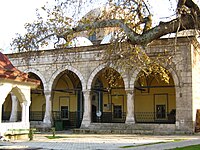Islam in North Macedonia

The Islam is in northern Macedonia after Christianity , the religion with the second highest number of followers. According to the 2002 census, 674,015 out of 2,022,547 inhabitants belonged to Islam , which makes up around 33.33 percent of the total population. North Macedonia is therefore the European country with the fifth largest proportion of Muslims in its population after Turkey , Kosovo , Albania and Bosnia and Herzegovina .
Since the Balkan state has been multiethnic for centuries , different ethnic groups or parts of them belong to the Muslim faith. Thus, Albanians , Turks and Bosniaks almost exclusively Muslims. Furthermore, a minority of the ethnic Macedonians ( Torbeschen and Gorans ) and the Roma belong to Islam.
Islam in northern Macedonia is mainly Sunni coined the law school of Hanafi is predominant. Also of Sufism has a long tradition in the country. There are a number of dervish monasteries that are maintained by different Sufi orders . This interpretation of Islam can be traced back to the country's Ottoman past . Between the 15th and early 20th centuries, the region was part of the Ottoman Empire.
Since the independence of North Macedonia in 1991, however, Wahhabis , Salafists , Shiites and supporters of other branches of Islam, which differ significantly from the tradition in North Macedonia, have spread among Muslims .
Demographics
The highest proportions of Muslims in the community population are primarily in the west of the country, mainly in the settlement area of the Albanian and Turkish minorities. Muslims make up the vast majority of the population in the cities of Debar , Gostivar and Tetovo . There are significant minorities in the cities of Struga , Kičevo , Skopje , Kumanovo and Veles .
history
The first contacts between the Christian inhabitants of Macedonia and Islam existed before the military incursion of the Ottomans in the Balkans. Wandering dervishes and merchants in transit shaped the early image of the new religion. Occasionally, the former founded small monasteries.
In 1371 the gradual conquest of Macedonia by the Ottoman Empire began. Thessaloniki fell for the first time in 1387 and Skopje fell in 1392 . However, Bitola and Prilep had already been conquered in 1385. The region remained under the rule of Constantinople for over 500 years . The new areas were administered in the province of Rumelia .
Under the Ottoman rule, however, Christians and Jews enjoyed comparatively many rights and were not specifically discriminated against in their religious activities. Rather, the Ottomans tried to balance the various religions and ethnicities in the empire in the so-called Millet system , which mostly succeeded. Nevertheless, the Ottoman Empire continuously lost power in the early 19th century and repeatedly had to give up territory to its neighbors. The “sick man on the Bosporus” finally lost a lot of power with the strong rise of nationalism in his country. With the independence of Greece (1830), Bulgaria (1870), Serbia (1817), Montenegro (1878) and Albania (1912), the Islamic state finally broke up and with it the organization of Muslims, which now had to reorganize.
In the Kingdom of Yugoslavia , which existed from 1918 to 1941, the Muslims were initially united under the religious leadership of the reis-ul ulema ( Grand Mufti ) of Sarajevo . In 1930 the official seat of the reis-ulema was temporarily relocated to Belgrade . The community of Muslims was divided with the introduction of a Council of Scholars ( ulema-medžlis ) in Sarajevo for the north and one in Skopje for southern Serbia (including North Macedonia). The official Muslim organizations propagated the Hanafi teaching tradition of Islam, but behaved negatively towards the Sufi currents of the Albanians, which were particularly widespread in Kosovo and North Macedonia. The local Sufi training institutions ( Tekken ) developed in secret into centers of Albanian nationalism.
During the time of the Socialist Federal Republic of Yugoslavia , Muslims were recognized as a religious community and the construction of mosques and Koran schools was encouraged. After all, in the 1970s, 12.3 percent of the Yugoslav population was Muslim.
After the Yugoslav Wars, Islam really flourished in North Macedonia. Large new mosques were built and are still being built today, but at the same time Macedonian Orthodox churches and illuminated crosses are being built in their vicinity. This ethno-religious conflict arose early in the history of the young Republic of Macedonia. During the Albanian uprising in 2001 , the conflict between the Christian Macedonians and the Muslim Albanians escalated. Since then, the situation has calmed down significantly, yet there are attacks on mosques and churches almost every year, not only on newer but also on older, culturally, historically and architecturally significant buildings.
Important Ottoman mosques
| Surname | image | place | Perfect |
|---|---|---|---|
| Colorful mosque | Tetovo | 1495 | |
| Colorful mosque | Skopje | 1438 | |
| Isa Bey Mosque | Skopje | 1475 | |
| Mustafa Pasha Mosque | Skopje | 1492 | |
| Sultan Murad Mosque | Skopje | 1436 | |
| Jeni mosque | Bitola | 1558 | |
| Murad Pasha Mosque | Skopje | 1436 | |
| Gazi Haydar Kadi Mosque | Bitola | 1561 | |
| Isak Çelebi Mosque | Bitola | 1506 | |
| Hünkar mosque | none available | Debar | 1468 |
| Husameddin Pasha Mosque | Štip | 1570 | |
| Čarši mosque | Prilep | 1475 |
literature
- Nexhat Ibrahimi: Islami në trojet iliro-shqiptare gjatë shekujve . Prishtinë 2000.
Individual evidence
- ↑ Census in Macedonia 2002. In: State Statistical Office. Retrieved September 14, 2013 (English, PDF file, 3.05 MB).
- ^ G. Krasniqi: The 'forbidden fruit': Islam and politics of identity among Albanians in Kosovo and Macedonia. Paper presented at After the Wahhabi mirage: Islam, politics and international networks in the Balkans, Oxford, June 21, 2010, p. 6f












